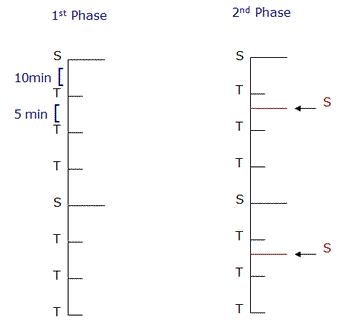PROBLEM-SOLVING THROUGH THE USE OF CUES AND BY ATTRIBUTION OF INTENTIONALITY TO OTHER INDIVIDUALS AMONG TUFTED CAPUCHINS (Cebus apella)
INTRODUCTION
Increasing importance has been given to social relationships as the source of the progressive development and complexity that characterizes the cognitive abilities observed in many species of primates (Byrne & Whiten, 1988). For individuals living in complex groups, it would be highly advantageous to have the capacity to rapidly and accurately interpret the signals sent by other individuals, as well as to be able to recognize not only the character of the simple social relations established in the group but also second-order social relations (Seyfarth & Cheney, 1988). Among the most interesting social cognition phenomena is the ability to understand second-order intentionality, or perspective-taking, that is, the ability to attribute objectives to the behaviors to other individuals (Mitchell & Thompson, 1986; Parkey, Mitchell & Boccia, 1994).
This type of cognitive capacity has been primarily investigated in great apes, especially chimpanzees (Byrne & Whiten, 1992; de Waal, 1986, 1992; Nishida, 1990). Among the New World primates, tufted capuchins (Cebus apella) show a great number of cognitive similarities to chimpanzees, and several studies have described the social structure developed in groups of tufted capuchins (Jason, 1986; van Schaik & van Noordwijk, 1989). However, there have been few studies investigating the social-cognitive skills of tufted capuchins. Prominent among the exceptions is a study carried out by Anderson et al. (1995). The authors concluded that tufted capuchins might, in fact, be able to attribute intentionality to other individuals.
The objective of this experiment was to determine whether or not, in the context of object-choice tasks, tufted capuchins are able to understand second-order intentionality.
MATERIALS AND METHODS
Subjects
Two 8-year-old (adult) male tufted capuchins, named Tiquinho (Tiny) and Alemão (German), were used. Both individuals were born in the wild and taken into captivity when they were still juveniles. They were then placed together with other individuals on islands. During the experiment, the individuals were transferred to isolated enclosures and held in cages (2 m × 2 m × 2 m).
The individuals were given a series of object-choice tasks conducted under two principal sets of conditions:
a-) Pre-test conditions ¾ the first task consisted of a pre-test in order to determine whether the subjects previously had the capacity to interpret information intentionally transmitted by others.
Four identical bowls were placed on a table (60 cm × 25 cm × 60 cm) with four depressions (2 cm deep, 8 cm in diameter, 8 cm apart), each depression cradling one bowl (Photograph 1).
In one of the depressions, a piece of food was hidden beneath the bowl. Each subject cage was covered with a wooden screen with articulated modules that allowed the opening of windows through which the subject could reach out and interact with the experimenters at the appropriate moments. Out of the subject line of sight, a quantity of food was hidden beneath one of the bowls. The hiding of the food (choice of depression/bowl) was performed in a random fashion. The table was positioned in front of the cage, and the experimenter sat on the other side of the table, facing the cage. The window of the screen was opened and the experimenter pointed to the bowl that, in that particular trial, hid the food hid the food (index finger held at a distance of 3 cm from the bowl for 3 s). The table was then positioned within the reach of the subject, and the task consisted of discovering which bowl contained the food and retrieving it. A total of 30 trials were carried out.
b-) Test conditions ¾ the procedure was carried out as before but with the following modification: each subject initially watched a simulation game played by two experimenters. In full view of the subject, two experimenters took their places facing each other across the table, which was now positioned perpendicularly to the cage (on a plane different from that which would later be used during the tests). It was incumbent upon one of the experimenters to point to the bowl hiding the food, while the other, reacting to this information, found the food and ate it. The procedure of presenting the table to the subject, as described for the pre-test phase, was then initiated.
The tests and experiments were carried out according to the following scheme: each simulation comprised 10 rounds, followed by a 10-min interval, after which the tests began. The tests were divided into 5-trial blocks, with a 5-min interval between each block. In the first phase, one simulation was followed by three blocks of tests. Another simulation was then carried out, and another three blocks of tests followed. In the second phase, a supplemental simulation was included after the first and fourth blocks of tests (see Diagram 1).

Diagram 1. Basic structure of the experimental design
| Key: T - Block of tests S - Simulations S - Supplemental simulation |
RESULTS
The results of the pre-tests are summarized in Table 1.
Table 1. Summary of the performance of the subjects on the pre-test
|
|
||
| Subject | Correct answers | Incorrect answers |
|
|
||
| Tiny | 6 | 24 |
| German | 5 | 25 |
|
|
||
The frequency of incorrect and correct answers shows that the subjects did not previously have the capacity to recognize the act of pointing as a useful, intentionally transmitted, piece of information (Binomial test, Unidirectional: Tiny: n = 30, p > 0.1; German: n = 30, p > 0.14).
The results of the tests are summarized in Table 2.
Table 2. Summary of the performance of the subjects in the two phases of the test
|
|
||||||
| Phase 1 | Phase 2 | |||||
|
|
||||||
| Subject | Correct answers |
Incorrect answers |
Time(s) |
Correct answers |
Incorrect answers |
Time(s) (x ± SE) |
|
|
||||||
| Tiny | 7 | 23 | 1.94 ± 0.5 | 4 | 26 | 2.8 ± 0.5 |
| German | 9 | 21 | 3.32 ± 1.92 | 7 | 23 | 0.7 ± 0.15 |
|
|
||||||
| SE: Standard error | ||||||
The frequency of incorrect and correct answers shows that, in the pre-tests, the subjects did not recognize the act of pointing as a way of intentionally transmitting information (Binomial test, Unidirectional: Tiny: n = 30, p > 0.17; German: n = 30, p > 0.13). The increase in simulation observation in the second phase was not enough to produce significant changes (Binomial test: Tiny: n = 30, p > 0.6; German: n = 30, p > 0.17). In fact, the frequency of correct answers decreased, for both subjects, in the second phase of the tests despite the increase in the number of simulations. Nevertheless, the statistical analysis revealed that the change in the frequencies of correct answers from one phase to the next was not significant for any of the subjects (McNemar test: Tiny: c² = 0.36; p > 0.5; German: c²= 0.6; p > 0.8).
DISCUSSION
Our results suggest that tufted capuchins are unable to understand second-order intentionality, at least in situations in which the intentional exchange of information occurs between members of different species (human and non-human primates).
In the present experiment, unlike in that carried out by Anderson et al. (1995), we were careful to previously evaluate whether the experimental subjects had any prior knowledge relating to the act of pointing. This determination is necessary, since positive responses to this act might have been motivated by some type of associative learning and not by genuine perspective-taking. The latter presupposes that the subject performing the act does so based on the construction of an abstract model, derived from the observation of a situation in which two or more individuals are involved and establish reciprocal interactions. The slightly positive result observed in the experiment carried out by Anderson et al. might have been obtained due to a previously established associative connection rather than to a concrete situation of attributing intention to other individuals, with the consequent strategic extraction of information based on this attribution.
The general conclusion suggested by the results of the present study is that it would be premature to assume that tufted capuchins are able to understand second-order intentionality. Many further studies, involving progressively more rigid experimental protocols as well as greater numbers of experimental subjects, are needed in order to answer this question once and for all.
REFERENCES
Anderson, J. R., Salberry, P., & Barbier, H. 1995. Use of experimenter-given cues during object-choice tasks by capuchin monkeys. Animal Behaviour, 49: 201-8.
Byrne, R. W., & Whiten, A. 1992. Cognitive evolution in primates: Evidence from tactical deception. Man (N.S.), 27: 609-27.
de Waal, F. B. M. 1986. Deception in the natural communication of chimpanzees. In Deception, eds. R. W. Mitchell & N. S. Thompson, pp. 221-44. Albany: State University of New York Press.
de Waal, F. B. M. 1992. Intentional deception in primates. Evolutionary Anthropology, 1: 86-92.
Jason, C. H. 1986. The mating system as a determinant of social evolution in capuchin monkeys (Cebus). In, J. G. Else & P. C. Lee eds. Primate Ecology and Conservation. pp. 169-79. New York: Cambridge University Press.
Mitchell, R. W., & Thompson, N. S (eds.). 1986. Deception: perspectives on human and nonhuman deceit. Albany: State University of New York Press.
Nishida, T. 1990. Deceptive behavior in young chimpanzees: An essay. In, The Chimpanzees of the Mahale Mountain: Sexual and Life History Strategies. ed. T. Nishida, pp. 285-89. Tokyo: University of Tokyo Press.
Parker, S. T., Mitchell R. W., & Boccia, M. L. (eds.). 1994. Self-awareness in Animals and Humans: Developmental Perspectives. New York: Cambridge University Press.
Seyfarth, R. M. & Cheney, D. L. 1988. Do monkeys understand their relations? In, Machiavellian Intelligence: Social Expertise and Evolution of Intellect in Monkeys, Apes, and Humans, eds. R. W. Byrne & A. Whiten, pp. 69-84. Oxford: Claredon Press.
van Schaik, C. P. & van Noordwijk, M. A. 1989. The special role of male Cebus monkey in predation avoidance and its effect on group composition. Behavioral Ecology and Sociobiology, 24: 265-76.
Whiten, A. (ed.). 1991. Natural Theories of Mind: Evolution, Development and Simulation of Everyday Mindreading. Oxford: Basil Blackwell Ltd.
FIGURE LEGEND
Figure 1. Basic structure of the experimental design






